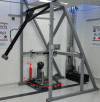Hockey STAR: A Methodology for Assessing the Biomechanical Performance of Hockey Helmets
- PMID: 25822907
- PMCID: PMC4569651
- DOI: 10.1007/s10439-015-1278-7
Hockey STAR: A Methodology for Assessing the Biomechanical Performance of Hockey Helmets
Abstract
Optimizing the protective capabilities of helmets is one of several methods of reducing brain injury risk in sports. This paper presents the experimental and analytical development of a hockey helmet evaluation methodology. The Summation of Tests for the Analysis of Risk (STAR) formula combines head impact exposure with brain injury probability over the broad range of 227 head impacts that a hockey player is likely to experience during one season. These impact exposure data are mapped to laboratory testing parameters using a series of 12 impact conditions comprised of three energy levels and four head impact locations, which include centric and non-centric directions of force. Injury risk is determined using a multivariate injury risk function that incorporates both linear and rotational head acceleration measurements. All testing parameters are presented along with exemplar helmet test data. The Hockey STAR methodology provides a scientific framework for manufacturers to optimize hockey helmet design for injury risk reduction, as well as providing consumers with a meaningful metric to assess the relative performance of hockey helmets.
Keywords: Acceleration; Concussion; Impact; Linear; Risk; Rotational.
Figures






Similar articles
-
Evaluation of cricket helmet performance and comparison with baseball and ice hockey helmets.Br J Sports Med. 2003 Aug;37(4):325-30. doi: 10.1136/bjsm.37.4.325. Br J Sports Med. 2003. PMID: 12893718 Free PMC article.
-
A method of evaluating helmet rotational acceleration protection using the Kingston Impact Simulator (KIS Unit).Clin J Sport Med. 2013 Nov;23(6):470-7. doi: 10.1097/JSM.0b013e318295a80f. Clin J Sport Med. 2013. PMID: 24080785
-
Development of the STAR evaluation system for football helmets: integrating player head impact exposure and risk of concussion.Ann Biomed Eng. 2011 Aug;39(8):2130-40. doi: 10.1007/s10439-011-0322-5. Epub 2011 May 7. Ann Biomed Eng. 2011. PMID: 21553135
-
[Traumatic brain injuries in winter sports : An overview based on the winter sports skiing, snowboarding and ice hockey].Orthopadie (Heidelb). 2022 Nov;51(11):920-928. doi: 10.1007/s00132-022-04318-6. Epub 2022 Oct 13. Orthopadie (Heidelb). 2022. PMID: 36227361 Review. German.
-
Managing head injury risks in competitive skateboarding: what do we know?Br J Sports Med. 2021 Aug;55(15):836-842. doi: 10.1136/bjsports-2020-102013. Epub 2020 Oct 8. Br J Sports Med. 2021. PMID: 33032991 Review.
Cited by
-
Equestrian STAR: Development of an Experimental Methodology for Assessing the Biomechanical Performance of Equestrian Helmets.Ann Biomed Eng. 2025 Sep;53(9):2309-2332. doi: 10.1007/s10439-025-03723-0. Epub 2025 Apr 28. Ann Biomed Eng. 2025. PMID: 40293632 Free PMC article.
-
Whitewater Helmet STAR: Evaluation of the Biomechanical Performance and Risk of Head Injury for Whitewater Helmets.Ann Biomed Eng. 2022 Nov;50(11):1520-1533. doi: 10.1007/s10439-022-03090-0. Epub 2022 Oct 7. Ann Biomed Eng. 2022. PMID: 36207617
-
Evaluation of a novel bicycle helmet concept in oblique impact testing.Accid Anal Prev. 2019 Mar;124:58-65. doi: 10.1016/j.aap.2018.12.017. Epub 2019 Jan 8. Accid Anal Prev. 2019. PMID: 30634159 Free PMC article.
-
Development of the STAR Evaluation System for Assessing Bicycle Helmet Protective Performance.Ann Biomed Eng. 2020 Jan;48(1):47-57. doi: 10.1007/s10439-019-02330-0. Epub 2019 Aug 1. Ann Biomed Eng. 2020. PMID: 31372859 Free PMC article.
-
Comparison of Impact Performance between Youth and Varsity Football Helmets.Proc Inst Mech Eng P J Sport Eng Technol. 2017 Dec;231(4):374-380. doi: 10.1177/1754337117731989. Epub 2017 Oct 3. Proc Inst Mech Eng P J Sport Eng Technol. 2017. PMID: 29417958 Free PMC article.
References
Publication types
MeSH terms
LinkOut - more resources
Full Text Sources
Other Literature Sources

